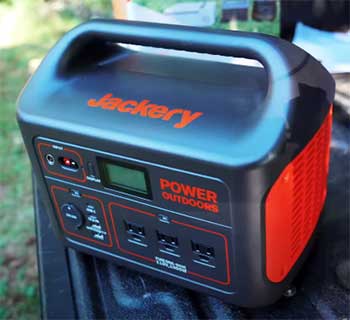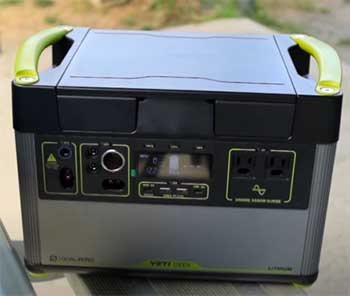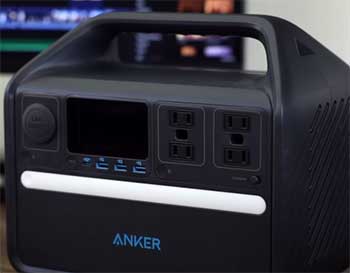Portable power stations have become incredibly popular in recent years. With frequent power outages, more people camping and working remotely, and a general need for energy independence, having a reliable portable power source makes sense.
But with so many options on the market, it can be tough to choose the right one.
In this comprehensive guide, we’ll compare three of the top portable power station brands: Jackery, Goal Zero, and Anker. We’ll look at the pros and cons of each brand’s most popular models to help you decide which is the best fit for your needs and budget.
A Brief Comparison Table
To summarize the key distinctions between the three brands:
| Aspects | Jackery | Goal Zero | Anker |
| Battery Capacity | Very high | Moderate | High |
| Solar Recharging | Available separately | Integrated in some models | Available separately |
| Portability | Bulky/heavy | Sleek/light | Compact for capacity |
| Price | Moderate | Expensive | Budget |
| Premium Features | Basic displays | Sophisticated app & screens | Basic |
| Warranty | 24 months | 12 months | 24 months |
Jackery – The Battery Life Leader
Jackery is one of the original and most well-known players in the portable power station game. They’ve been around since 2012 and have continued to innovate and release new models over the years. Jackery’s main strengths are battery capacity, versatility, and overall value.
Some of Jackery’s most popular power stations include:

- Jackery Explorer 500 – 518Wh capacity. Can charge phones 45+ times, a laptop 10+ times, or run small appliances. Great balance of capacity and portability.
- Jackery Explorer 1000 – 1002Wh capacity. Enough juice to run a mini fridge for 8+ hours or high drain appliances. Higher capacity than most competitors.
- Jackery Solar Generator 2000 Pro – 2160Wh capacity with solar recharging. Provides full off-grid solar power for camping & emergencies.
Pros:
- Very high battery capacities for the price
- Fast recharging times of only 2-3 hours with fast charger
- Can be solar recharged with optional solar panels
- Multiple output ports including AC, USB-C, USB-A, 12V carport
- Easy to use with clear LCD displays
Cons:
- Bulky and heavy, especially the higher capacity models
- LCD screens lack sophisticated smartphone apps
- Optional solar panels add to cost
Overall, Jackery is ideal for anyone who prioritizes battery capacity and versatility for powering larger devices and appliances. The tradeoff is portability, but the robust batteries provide some of the longest runtimes on the market.
Also Read: Differences Between Jackery 880 And 1000 Portable Power Stations.
Goal Zero – The Premium Portable Solar Power
While Jackery focuses on battery capacity, Goal Zero places more emphasis on sleek design, portability, and solar recharging. They were also early pioneers of portable solar generators starting in 2009.
Goal Zero builds premium products though comes at a higher cost than Jackery.
Some of Goal Zero’s most popular portable power stations:

- Yeti 500X – 505Wh capacity. Great balance of capacity, features, and portability.
- Yeti 1000X – 983Wh capacity. High capacity to power larger devices for longer.
- Yeti 1500X – 1516Wh capacity with 3000W inverter for powering high drain appliances.
- Yeti 3000X – 3063Wh capacity, Goal Zero’s largest model with app monitoring.
Pros:
- Sleek, lightweight, and stylish designs
- Built-in MPPT solar controllers for fast solar recharging
- Smartphone app with usage stats and remote control
- 2000W and higher inverter models for heavy duty appliances
- Higher peak power for surge loads
Cons:
- More expensive than Jackery
- Solar panels are very costly addons
- Small LCD screens not asfunctional as Jackery’s
Goal Zero is best for eco-conscious users who want maximum portability combined with solar recharging. The capacities may be lower for the price but the high-end designs and solar capabilities provide key advantages.
Anker – The Affordable New Option
Anker entered the portable power station market more recently in 2021. As a respected tech accessories brand, Anker took the approach of undercutting Jackery and Goal Zero pricing with more budget-friendly options.
Here are some of Anker’s top selling models:

- Anker 757 PowerHouse – 1024Wh capacity. High capacity at a lower price point.
- Anker 521 PowerHouse – 505Wh capacity. Compact and lightweight. Good balance of price, size, and capacity.
- Anker 625 Solar Generator – 624Wh capacity with 400W solar input. Integrated solar at a competitive price.
Pros:
- More affordable than other top brands
- Lightweight, compact designs for the capacity
- Fast charging capabilities
- PowerIQ ports adjust to connected devices
- 24-month warranty included
Cons:
- Still new to market, so longevity is uncertain
- Minimal after-purchase support and troubleshooting
- No sophisticated apps or displays
For budget-focused shoppers, Anker provides a lot of value and capacity at lower price points. The tradeoffs are less premium features and accessories compared to Jackery and Goal Zero. But for portable power basics, Anker gets the job done.
Also Read: Comparison of Battle Born And RELiON Batteries.
Which Is Better For Camping & Outdoors?
For camping and outdoor adventures, Goal Zero’s integrated solar recharging and lighter designs make them the preferred choice for off-grid usage. Models like the Yeti 1500X can be paired with folding solar panels to provide endless power on the go.
Jackery’s separate solar panels require a less seamless setup.
That said, Jackery’s higher battery capacities allow their models to run critical devices for longer between charges. So for extended wilderness trips of a week or more, some may prefer Jackery’s extra juice and simpler interfaces.
Which Is Better For Emergency Power?
In emergency situations like power outages from storms, you want maximum power to run fridges, lights, routers and other household necessities.
Since Jackery offers the largest battery capacities that allow high-drain devices to run for multiple hours or days, most would choose Jackery for emergency preparedness. Their output ports also allow easy connection to home devices.
Goal Zero and Anker models still offer sufficient capacity for emergency needs but their lower capacity options may require more selective usage during prolonged outages.
Their smaller and more portable designs are better suited for using energy selectively on the go during disasters.
Which Is Better For Road Trips?
Road trips require power both on the drive and at overnight campsites. Goal Zero’s integrated solar is convenient for recharging via sunlight during the day. Jackery’s higher capacities mean less frequent need to recharge overnight.
And Anker provides affordable power for budget road trippers.
Any model with a carport outlet will allow recharging while driving. In terms of portability, the mid-sized models from any brand will be easiest for moving in and out of a vehicle. So your choice comes down to solar needs, capacity preferences, and budget.
Also Read: Comparison of Autozone And Walmart Batteries.
FAQ – Portable Power Station Questions
For most users, Jackery is the better overall choice compared to Anker power stations. Jackery offers higher battery capacities for roughly the same price as Anker. This allows you to power more devices for longer. Jackery’s designs also include useful features like LCD screens, multiple output ports, fast charging capabilities, and more accessory options. The only advantages of Anker are the lower cost and smaller/lighter devices.
Jackery batteries have much higher capacities compared to similarly priced Goal Zero models. However, Goal Zero offers sleeker portable designs, premium features like smartphone apps, and built-in solar recharging on some models. Jackery is better for budget buyers prioritizing capacity and runtime. Goal Zero is better for those wanting portable solar power and premium features.
Yeti is Goal Zero’s primary portable power station line. Jackery options are generally considered better than Yeti models because of the much lower price for similar or higher capacities. Goal Zero focuses more on premium design. So unless you specifically want Goal Zero’s integrated solar recharging or mobile app monitoring, Jackery packs more value overall.
For overall value across performance, features, capacity, and price, the Jackery Explorer 1000 is arguably the best portable power station available. With 1002Wh capacity, a fast charging time, all the necessary output ports, an easy-to-use display, and lower cost than competitors, it hits a sweet spot that makes it our top recommendation for most users’ needs. The Jackery Explorer 1500 and Explorer 2000 are the best for even higher capacity needs.
Key Takeaways – Which Is Right For You?
- Jackery is the leader for battery life and capacity. Their models offer some of the longest runtimes for powering devices, appliances, and emergency home usage.
- Goal Zero provides the most premium portable solar power options thanks to integrated panels and sleek designs. They are the choice for eco-conscious adventurers.
- Anker delivers value and capacity in a more affordable package. They are ideal for budget buyers who still want decent power and runtimes.
Think about the size of devices you want to power, how long you need them to run, and any solar recharging needs. This will guide you towards the right brand and capacity.
And look for a range of output options for flexibility, along with key features like fast charging, LCD screens, and warranties.
With portable power stations now available from hundreds of brands, it can be hard to narrow down your best option. By directly comparing the leaders like Jackery, Goal Zero and Anker, this guide provides an in-depth breakdown of the real differences and helps highlight the right portable power station for your unique needs.
Let us know if you have any other questions!

